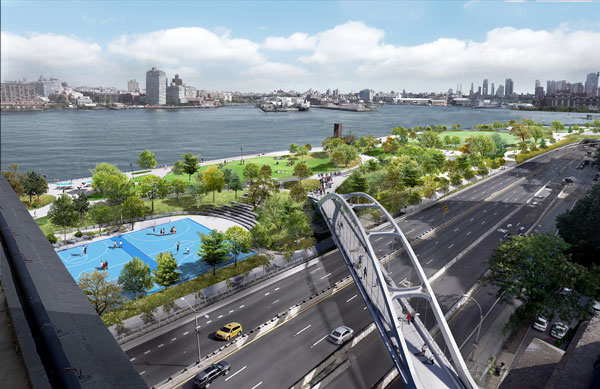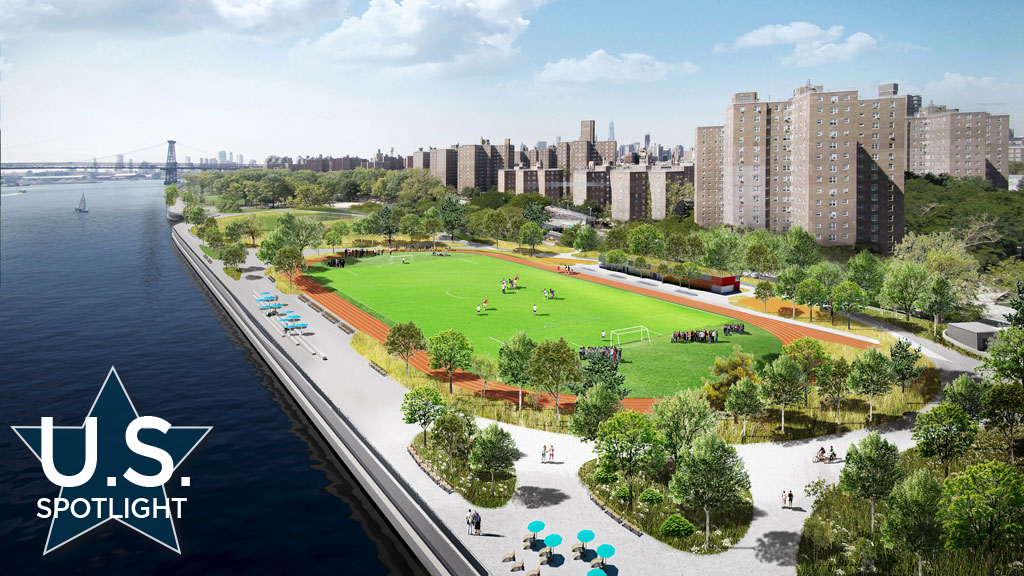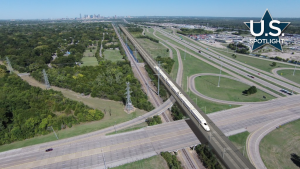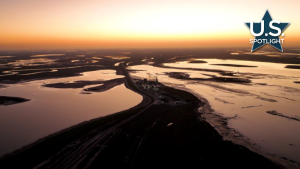A 2.4-mile stretch of shoreline along the East River in Lower Manhattan is undergoing a multi-year project to protect the lowest lying neighborhoods on the island from rising sea level and storms the likes of Hurricane Sandy that caused roughly $19 billion damage to New York City in 2012.
Tabbed at $1.45 billion the ambitious flood protection initiative by the city integrates a series of cast-in-place concrete floodwalls, 18 steel floodgates, berms and raised parkland to heights of eight-to 10-feet above existing grade.
Called the East Side Coastal Resiliency (ESCR) project, it is the first leg of the proposed “big U” – a 10-mile ribbon of protection extending from midtown on the west side of Manhattan south around the tip of the island and north up to the east side, Ian Michaels, executive director for public information, New York City Department of Design and Construction (DDC), told the Daily Commercial News.
BIG won a U.S. government sponsored competition to oversee the project. The design firm is based out of New York City and Copenhagen.
In July the second gate at about 80-feet long of the ESCR will be hoisted by a crane onto tracks and into position along the concrete wall, says Tariq Bashir, executive project director of ESCR, for the DDC. The smaller first gate that weighed 16 tons was placed with a 190-foot tall mobile crane earlier this year.
Gate installation is tricky and “perfect alignment” with the concrete wall is critical to ensuring a watertight fit, Bashir says, adding a below grade barrier consisting of sheets of steel will prevent seepage during storms.
The multi-ton metal gates are manufactured by Linita Design & Manufacturing Corp. in Lackawanna near Buffalo.
While some of the 18 gates will slide on rollers, others will be designed to swing open.
Bashir says the construction program is complex and poses numerous first-time challenges for the building team which is probably why the construction community showed little interest in bidding on the original tender package.
“You really need an all-rounder (contractor)…someone with lots of skillsets. You can imagine how difficult it is for them to balance the risk and make a profit,” he says, noting the original tender was repackaged, retendered and even then only received two bids.
IPC Resiliency Partners, a tri-venture was awarded the contract.
From the outset, the ESCR has faced difficulties, including getting the community of 110,000 residents on side with disruptions caused by construction that will carry on into 2026.
But the flood protection project is not just about building a big barrier to the sea.
There will be improvements to public open spaces and amenities, including waterfront access via three new pedestrian bridges.
Work will be phased to keep parkland such as portions the 57-acre East River Park partly open at all times, says Michaels.
Bashir says one of the complications with excavation has been that some of the as-built drawings of underground utilities are inaccurate, which has required a design rework of foundation walls in some locations.
Michaels says while most of the work is being done above grade, a critical component to the ESCR’s success is sewer expansion and improvements to prevent “a bathtub effect where water builds up inside the protected area.”
Two interceptor gates underground will independently block off the area to prevent flooding into a pump station, explains Thu-Loan Dinh, a lead designer, DDC.
Michaels says the vulnerable neighborhood has 28,000 people living in public housing, many of whom are probably not financially equipped to weather another flood or disaster on the scale of Hurricane Sandy.
The flood barrier, which is designed to accommodate a future additional two feet of height, is being engineered to meet the worst-case storm scenario in 2050, based on projections by the New York City Panel on Climate Change, an independent group of climate scientists.
The project is receiving a $338 million grant from the U.S. government. The City of New York is covering the rest of the bill.
“People ask us all the time about the expense and the hassle and time (to build this project) and my personal point of view is that it just has to work once,” says Michaels.












Recent Comments
comments for this post are closed